Plastics, polystyrene and e-waste
According to plastics New Zealand about 20% of plastics processed in NZ are for construction purposes, however recycling of construction plastics is very limited.
Plastics are used in NZ construction for various purposes from the short term (such as packaging of materials) to the long term (such as electric cabling and plumbing). Some of the major issues in plastics recycling are the removal of contaminates, lack of and ability to identify types of plastics and local market demand.
The main problems with polystyrene waste are that because it is very bulky, it takes up a lot of room at landfills. This is not necessarily reflected in landfill charges because they are based on weight. The decomposition process is also very slow. Polypalace in Porirua, are currently recycling polystyrene of which large amounts come from the film industry for use as under floor insulation and are supporters of this project.
Plastics and polystyrene student work
- Cleon Ferreira - Polystyrene Planter Kit - Porirua City Council Prize 2010
- Kendra Manning - Polystyrene Construction Glue 2010
- Eve McLachlan - Polystyrene Green Roof 2010
- Duncan Harding - Mercury Remediation from Fluorescent Tubes System WasteMINZ Best Project 2009
- Patrick Smart - Plastic Bottle Stool 2007
- Katrina Tamaira - ‘Korulastic’ WasteMINZ First Prize 2006
- Charlotte Hoare - ‘Polywrap’ Zerowaste Trust New Zealand Best Report Prize 2006
- Caleb Sillars - Thermal Blind to Enhance Photodegradation 2006
- Peter Lim - Thermal Insulation Blocks 2004
- Kate Williams - Movable Shade Screen 2004
Cleon Ferreira - Polystyrene Planter Kit - Porirua City Council Prize
Cleon won the 2010 Porirua City Council Prize for the project with the most potential to reduce waste to landfill with her simple design of polystyrene pieces that can be assembled, much like a jigsaw into outdoor planter beds for gardens. The advantages over the usual treated timber planter boxes available include utilisation of the insulation characteristics of polystyrene to keep plants warmer and therefore enable them to be faster growing, no leaching of chemicals, longer lasting, cheaper, and made from 100% recycled and reformed polystyrene.
Kendra Manning - Polystyrene Construction Glue 2010
Kendra discovered that through using citrus concentrate and acetone she could create a strong adhesive or filler from waste polystyrene.
Eve McLachlan - Polystyrene Green Roof 2010
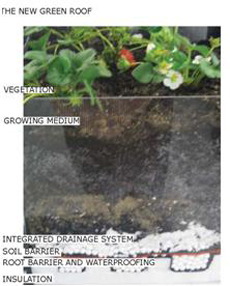
Eve, a landscape architecture student experimented with replacing aggregate commonly used in intensive green roof systems with polystyrene. The polystyrene allows drainage to occur but makes for a much lighter green roof system. This means more soil could be added instead of allowing for greater plant growth and could allow for green roofs to be more easily retrofitted onto existing buildings.
Duncan Harding - Mercury Remediation from Fluorescent Tubes System WasteMINZ Best Project 2009
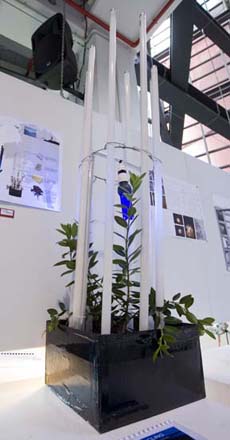
Duncan, an architecture student designed a collection point for used fluorescent tubes which also serves to remediate the mercury content from them before they are recycled.
The system uses the process of phytomining, which is the ability of plants to absorb heavy metals from their surroundings.
Used tubes are planted upright into soil containing plants that take mercury up into their structure.
The mercury can then be mined later from the plants.
The collection point also makes use of the excess phosphors left in the tubes.
By shining a single source of UV light onto them the tubes glow providing ambient low level light suitable for circulation lighting within offices or security lighting.
Patrick Smart - Plastic Bottle Stool 2007
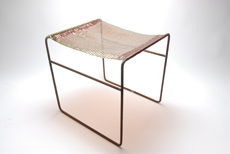
Patrick, an architecture student devised a simple and fast method for turning plastic bottles into thick and flexible strips of plastic using a lath. These long strips could then be woven together to make a strong and durable fabric. The light quality of the material was commended.
Katrina Tamaira - ‘Korulastic’ WasteMINZ First Prize 2006
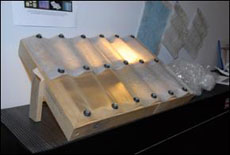
Katrina Tamaira, a development studies student won the overall prize for 2006 for her plastic corrugated roof sheet made from combining layers of problematic packing cling film / shrink wrap waste. The finished prototype behaved in a manner similar to new plastic roofing sheets with increased light diffusion properties. The potential of the product to utilise photodegradation was also explored to minimise eventual waste to landfill.
Charlotte Hoare - ‘Polywrap’ Zerowaste Trust New Zealand Best Report Prize 2006
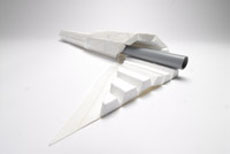
‘Polywrap has been developed to provide an adaptable and efficient lagging system that will reduce energy consumption associated with heating water. Made from of waste polystyrene and ‘Cling Film,’ Polywrap is a viably sustainable material which addresses New Zealand’s waste problems. With excellent insulating ability Polywrap retains internal temperatures within water pipes keeping them up to 15˚c warmer, as well as preventing them from freezing and cracking during winter months’.
Caleb Sillars - Thermal Blind 2006
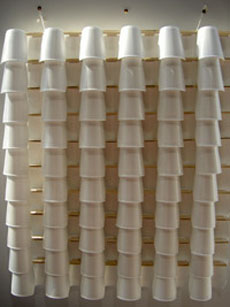
Caleb Sillars designed a product reducing the amount of time a polystyrene cup needs to biodegrade by employing the degrading effect of NZ’s harsh UV light, in a aesthetically pleasing and useful way.
The thermal blind uses the insulating characteristics of polystyrene cups and has been designed to be reversible, in order to expose cups to the maximum amount of sunlight possible. The blind is able to concertina open and closed by using the stacking capability of the cups.
Peter Lim - Thermal Insulation Blocks 2004
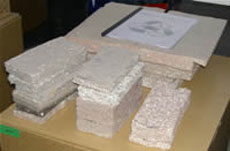
Waste expanded polystyrene and paper (or other cellulose wastes such as sawdust or timber) were combined by an interesting process to create interlocking insulation blocks for use as thermal insulation in floors, walls and ceilings.
Kate Williams - Movable Shade Screen 2004
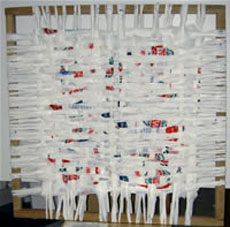
Plastic bags were woven and tightened over a timber frame to make a versatile shading screen. Proposed uses included use as an exterior shading eave over windows or as self supporting shade structures over picnic or play areas. The system was designed to be easily demountable using only an allen key, so bag weave can be replaced. The bags last for approximately one year and get a head start their long decomposition process by being exposed to the sun’s UV light breaking down faster than if buried in a landfill.
